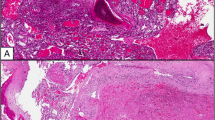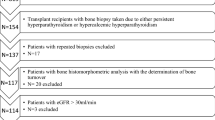Abstract
Purpose
To evaluate diagnostic and prognostic significance of plasma osteopontin (OPN) in patients with renal cell carcinoma (RCC).
Methods
The retrospective study included 80 patients with RCC (pN0M0, n = 32; pN1M0, n = 11; M1, and n = 37), and 52 healthy controls (27 females and 25 males). OPN, the bone marker bone-specific alkaline phosphatase (bALP) and carboxyterminal telopetide of type-I collagen (ICTP), and the enzymes alanine aminotransferase (ALAT), and gamma-glutamyltransferase (GGT) were evaluated together with Memorial Sloan-Kettering Cancer Center (MSKCC) laboratory parameters. Data were analyzed by receiver–operating characteristics (ROC), survival analysis, and Cox proportional hazards regression model.
Results
OPN and ICTP levels in RCC patients with distant metastases were significantly elevated (medians 115 and 4.7 μg/l, P < 0.001) compared to those without metastases (31.1 and 2.5 μg/l) and controls (28.9 and 2.1 μg/l) but did not differ between patients with bone or non-bone metastases. Both bALP and ALAT were not different between all study groups, while GGT was only increased in patients with non-bone metastases. In ROC analysis, OPN showed the best discrimination between patients with and without metastases (area under the curve: 0.888). High OPN values were associated with poor survival (Kaplan–Meier analysis, log-rank test, P = 0.002). Multivariate Cox regression with forward and backward stepwise elimination confirmed plasma OPN as independent predictive survival factor in RCC patients.
Conclusions
Our results show that high plasma OPN levels are associated with distant metastases and poor survival in RCC patients. The use of OPN as potential marker to monitor new treatment strategies in patients with advanced RCC should be evaluated in prospective studies.



Similar content being viewed by others
Abbreviations
- OPN:
-
Osteopontin
- RCC:
-
Renal cell carcinoma
- bALP:
-
Bone-specific alkaline phosphatase
- ICTP:
-
Carboxyterminal telopetide of type I collagen
- ALAT:
-
Alanine aminotransferase
- GGT:
-
Gamma-glutamyltransferase
- LDH:
-
Lactate dehydrogenase
- Ca:
-
Calcium
- tALP:
-
Total alkaline phosphatase
- Hb:
-
Hemoglobin
- ROC:
-
Receiver–operation characteristics
- 95% CI:
-
95% Confidence interval
References
Agrawal D, Chen T, Irby R, Quackenbush J, Chambers AF, Szabo M, Cantor A, Coppola D, Yeatman TJ (2002) Osteopontin identified as lead marker of colon cancer progression, using pooled sample expression profiling. J Natl Cancer Inst 94:513–521
Ang C, Chambers AF, Tuck AB, Winquist E, Izawa JI (2005) Plasma osteopontin levels are predictive of disease stage in patients with transitional cell carcinoma of the bladder. BJU Int 96:803–805
Bramwell VH, Doig GS, Tuck AB, Wilson SM, Tonkin KS, Tomiak A, Perera F, Vandenberg TA, Chambers AF (2006) Serial plasma osteopontin levels have prognostic value in metastatic breast cancer. Clin Cancer Res 12:3337–3343
Comabella M, Pericot I, Goertsches R, Nos C, Castillo M, Blas NJ, Rio J, Montalban X (2005) Plasma osteopontin levels in multiple sclerosis. J Neuroimmunol 158:231–239
Coppola D, Szabo M, Boulware D, Muraca P, Alsarraj M, Chambers AF, Yeatman TJ (2004) Correlation of osteopontin protein expression and pathological stage across a wide variety of tumor histologies. Clin Cancer Res 10:184–190
Das R, Mahabeleshwar GH, Kundu GC (2003) Osteopontin stimulates cell motility and nuclear factor kappaB-mediated secretion of urokinase type plasminogen activator through phosphatidylinositol 3-kinase/Akt signaling pathways in breast cancer cells. J Biol Chem 278:28593–28606
Fedarko NS, Jain A, Karadag A, Van Eman MR, Fisher LW (2001) Elevated serum bone sialoprotein and osteopontin in colon, breast, prostate, and lung cancer. Clin Cancer Res 7:4060–4066
Furger KA, Menon RK, Tuck AB, Bramwell VH, Chambers AF (2001) The functional and clinical roles of osteopontin in cancer and metastasis. Curr Mol Med 1:621–632
Henry NL, Hayes DF (2006) Uses and abuses of tumor markers in the diagnosis, monitoring, and treatment of primary and metastatic breast cancer. Oncologist 11:541–552
Hirama M, Takahashi F, Takahashi K, Akutagawa S, Shimizu K, Soma S, Shimanuki Y, Nishio K, Fukuchi Y (2003) Osteopontin overproduced by tumor cells acts as a potent angiogenic factor contributing to tumor growth. Cancer Lett 198:107–117
Hotte SJ, Winquist EW, Stitt L, Wilson SM, Chambers AF (2002) Plasma osteopontin: associations with survival and metastasis to bone in men with hormone-refractory prostate carcinoma. Cancer 95:506–512
Jemal A, Siegel R, Ward E, Murray T, Xu J, Thun MJ (2007) Cancer statistics, 2007. CA Cancer J Clin 57:43–66
Kashyap MK, Kumar A, Emelianenko N, Kashyap A, Kaushik R, Huang R, Khullar M, Sharma SK, Singh SK, Bhargave AK, Upadhyaya SK (2005) Biochemical and molecular markers in renal cell carcinoma: an update and future prospects. Biomarkers 10:258–294
Kim JH, Skates SJ, Uede T, Wong KK, Schorge JO, Feltmate CM, Berkowitz RS, Cramer DW, Mok SC (2002) Osteopontin as a potential diagnostic biomarker for ovarian cancer. JAMA 287:1671–1679
Koga S, Tsuda S, Nishikido M, Ogawa Y, Hayashi K, Hayashi T, Kanetake H (2001) The diagnostic value of bone scan in patients with renal cell carcinoma. J Urol 166:2126–2128
Kriteman L, Sanders WH (1998) Normal alkaline phosphatase levels in patients with bone metastases due to renal cell carcinoma. Urology 51:397–399
Le QT, Sutphin PD, Raychaudhuri S, Yu SC, Terris DJ, Lin HS, Lum B, Pinto HA, Koong AC, Giaccia AJ (2003) Identification of osteopontin as a prognostic plasma marker for head and neck squamous cell carcinomas. Clin Cancer Res 9:59–67
Motzer RJ, Bacik J, Murphy BA, Russo P, Mazumdar M (2002) Interferon-alfa as a comparative treatment for clinical trials of new therapies against advanced renal cell carcinoma. J Clin Oncol 20:289–296
Motzer RJ, Mazumdar M, Bacik J, Berg W, Amsterdam A, Ferrara J (1999) Survival and prognostic stratification of 670 patients with advanced renal cell carcinoma. J Clin Oncol 17:2530–2540
Orrell DH (1971) Albumin as an aid to the interpretation of serum calcium. Clin Chim Acta 35:483–489
Rangaswami H, Bulbule A, Kundu GC (2006) Osteopontin: role in cell signaling and cancer progression. Trends Cell Biol 16:79–87
Ries LAG, Eisner MP, Kosary CL, Hankey BF, Miller BA, Clegg L, Mariotto A, Feuer EJ, Edwards BK (2005) SEER cancer statistics review, 1975–2002. National Cancer Institute, Bethesda, MD
Rittling SR, Chambers AF (2004) Role of osteopontin in tumour progression. Br J Cancer 90:1877–1881
Rittling SR, Denhardt DT (1999) Osteopontin function in pathology: lessons from osteopontin-deficient mice. Exp Nephrol 7:103–113
Rousseau T, Peyret C, Zerbib M, Thiounn N, Flam T, Debre B (1994) Circumstances of the detection of kidney cancer. Current part of accidental discoveries. J Urol (Paris) 100:189–195
Scatena M, Almeida M, Chaisson ML, Fausto N, Nicosia RF, Giachelli CM (1998) NF-kappaB mediates alphavbeta3 integrin-induced endothelial cell survival. J Cell Biol 141:1083–1093
Shimada Y, Watanabe G, Kawamura J, Soma T, Okabe M, Ito T, Inoue H, Kondo M, Mori Y, Tanaka E, Imamura M (2005) Clinical significance of osteopontin in esophageal squamous cell carcinoma: comparison with common tumor markers. Oncology 68:285–292
Singhal H, Bautista DS, Tonkin KS, O’Malley FP, Tuck AB, Chambers AF, Harris JF (1997) Elevated plasma osteopontin in metastatic breast cancer associated with increased tumor burden and decreased survival. Clin Cancer Res 3:605–611
Standal T, Borset M, Sundan A (2004) Role of osteopontin in adhesion, migration, cell survival and bone remodeling. Exp Oncol 26:179–184
Tuck AB, Elliott BE, Hota C, Tremblay E, Chambers AF (2000) Osteopontin-induced, integrin-dependent migration of human mammary epithelial cells involves activation of the hepatocyte growth factor receptor (Met). J Cell Biochem 78:465–475
Wong TS, Kwong DL, Sham J, Wei WI, Kwong YL, Yuen AP (2005) Elevation of plasma osteopontin level in patients with undifferentiated nasopharyngeal carcinoma. Eur J Surg Oncol 31:555–558
Yoneda T (2006) Pathophysiology of osteolytic bone metastasis associated with solid cancers. Clin Calcium 16:16–24
Zekri J, Ahmed N, Coleman RE, Hancock BW (2001) The skeletal metastatic complications of renal cell carcinoma. Int J Oncol 19:379–382
Zhang H, Ye QH, Ren N, Zhao L, Wang YF, Wu X, Sun HC, Wang L, Zhang BH, Liu YK, Tang ZY, Qin LX (2006) The prognostic significance of preoperative plasma levels of osteopontin in patients with hepatocellular carcinoma. J Cancer Res Clin Oncol 132:709–717
Acknowledgments
Azizbek Ramankulov is supported by a grant from the German Academic Exchange Service. We thank Silke Klotzek and Janett Reiche for excellent technical assistance.
Author information
Authors and Affiliations
Corresponding author
Rights and permissions
About this article
Cite this article
Ramankulov, A., Lein, M., Kristiansen, G. et al. Elevated plasma osteopontin as marker for distant metastases and poor survival in patients with renal cell carcinoma. J Cancer Res Clin Oncol 133, 643–652 (2007). https://doi.org/10.1007/s00432-007-0215-z
Received:
Accepted:
Published:
Issue Date:
DOI: https://doi.org/10.1007/s00432-007-0215-z




